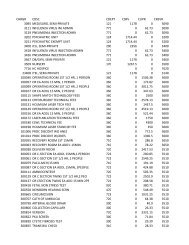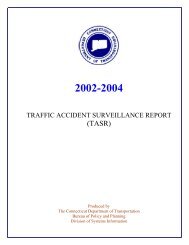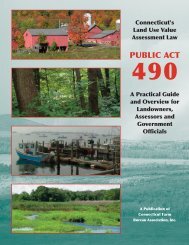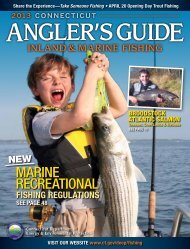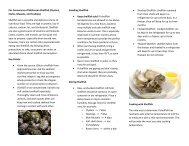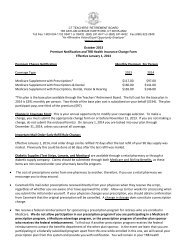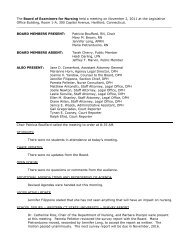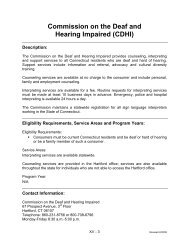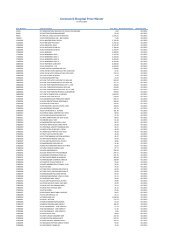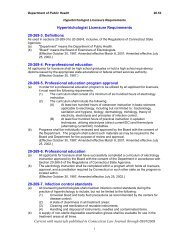Guidelines for Investigator's Boating Accident Report - CT.gov
Guidelines for Investigator's Boating Accident Report - CT.gov
Guidelines for Investigator's Boating Accident Report - CT.gov
Create successful ePaper yourself
Turn your PDF publications into a flip-book with our unique Google optimized e-Paper software.
Marine Headquarters and <strong>Boating</strong> Division<br />
333 Ferry Road • Old Lyme, <strong>CT</strong> 06371 www.ct.<strong>gov</strong>/deep Affirmative Action/Equal Opportunity Employer<br />
<strong>Guidelines</strong> <strong>for</strong> Investigator’s <strong>Boating</strong> <strong>Accident</strong> <strong>Report</strong><br />
Prepared by Eleanor Mariani, State <strong>Boating</strong> Law Administrator, DEEP <strong>Boating</strong> Division Director<br />
“<strong>Report</strong>able” <strong>Boating</strong> <strong>Accident</strong>s<br />
A vessel is considered to be involved in a “boating accident” whenever a death, missing person,<br />
injury beyond first aid, property damage greater than $500, or total vessel loss results from the<br />
vessel's operation, construction, seaworthiness, equipment, or machinery.<br />
The following are examples of accident types that would need to be reported to the Department of<br />
Energy and Environmental Protection:<br />
• Grounding, capsizing, sinking, or flooding/swamping<br />
• Falls in or overboard a vessel<br />
• Persons ejected from a vessel<br />
• Fire or explosions that occur while underway and while anchored, moored or docked if the fire<br />
resulted from the vessel or vessel equipment.<br />
• Water-skiing or other mishap involving a towable device<br />
• Collision with another vessel or object<br />
• Striking a submerged object<br />
• A person struck by a vessel, propeller, propulsion unit, or steering machinery<br />
• Carbon monoxide exposure<br />
• Electrocution due to stray current related to a vessel<br />
• Casualties while swimming from a vessel that is not anchored, moored or docked.<br />
• Casualties where natural causes served as a contributing factor in the death of an individual but<br />
the determined cause of death was drowning.<br />
• Casualties from natural phenomena such as interaction with marine life (i.e. leaping sturgeon<br />
causes casualty to person) and interaction with nature (i.e. mountain side falls onto vessel<br />
causing casualties).<br />
• Casualties where a person falls off an anchored vessel.<br />
The DEEP is required to submit all reportable boating accidents to the USCG within 30 days of the<br />
date of occurrence of the accident. There<strong>for</strong>e, all law en<strong>for</strong>cement agencies must submit their<br />
accident reports prior to 30 days. If an investigation precludes the accident report from being<br />
complete, submit as much as possible and note that further investigation is required. Please send<br />
all reports to:<br />
Miraflor Powe<br />
DEEP <strong>Boating</strong> Division<br />
333 Ferry Road, P.O. Box 280, Old Lyme, <strong>CT</strong> 06371-0280 Phone: 860-434-8638<br />
Revised 5/13
“Non-<strong>Report</strong>able” <strong>Boating</strong> <strong>Accident</strong>s<br />
Not every occurrence involving a vessel must be reported. The following occurrences involving an<br />
accident with a vessel are not required to be reported:<br />
• A person dies, is injured, or is missing as a result of self-inflicted wounds, alcohol poisoning,<br />
gunshot wounds, or the ingestion of drugs, controlled substances or poison.<br />
• A person dies, is injured, or is missing as a result of assault by another person or persons<br />
while aboard a vessel.<br />
• A person dies or is injured from natural causes while aboard a vessel.<br />
• A person dies, is injured, or is missing as a result of jumping, diving, or swimming <strong>for</strong> pleasure<br />
from an anchored, moored or docked vessel.<br />
• A person dies, is injured, or is missing as a result of swimming to retrieve an object or a vessel<br />
that is adrift from its mooring or dock, having departed from a place of inherent safety,<br />
such as the shore or pier.<br />
• Property damage occurs or a person dies, is injured, or is missing while preparing a vessel<br />
<strong>for</strong> launching or retrieving and the vessel is not on the water and capable / ready <strong>for</strong> its<br />
intended use.<br />
• Property damage occurs or a person dies, is injured, or is missing as a result of a fire on<br />
shore or a pier that spreads to a vessel or vessels.<br />
• Property damage occurs to a docked or moored vessel or a person dies, is injured, or is<br />
missing from such a vessel as a result of storms, or unusual tidal or sea conditions; or when<br />
a vessel gets underway in those conditions in an attempt to rescue persons or vessels.<br />
• Property damage occurs to a docked or moored vessel due to lack of maintenance on the<br />
vessel or the structure to which it was moored.<br />
• Property damage occurs to a docked or moored vessel due to theft or vandalism.<br />
• Property damage occurs to, a person dies or is injured on, or a person is missing from a non<br />
-propelled houseboat or other vessel used primarily as a residence when such a vessel is<br />
not underway.<br />
• Property damage to the all vessels involved in an accident is $500 or less.<br />
• Casualties that result from falls from or on docked vessels or vessels that are moored to a<br />
permanent structure.<br />
• Casualties that result from a person climbing aboard an anchored vessel from the water or<br />
swimming near an anchored vessel.<br />
• Fire or explosions on anchored, docked or moored boats where the cause of the fire was<br />
not attributed to the vessel or vessel equipment.<br />
• Casualty or damage that results when the vehicle used <strong>for</strong> trailering the vessel fails.<br />
• Casualties or damage that occur during accidents that only involve unmodified inner tubes.<br />
• Casualties or damage that occur when the only vessel(s) involved are being used solely <strong>for</strong><br />
<strong>gov</strong>ernmental, commercial or criminal activity.<br />
• Casualties or damage that occur when the only vessel(s) involved are not numbered and<br />
are being used exclusively <strong>for</strong> racing.<br />
2
• Casualties or damage that occur when the only vessel(s) involved are <strong>for</strong>eign vessels and<br />
thus not subject to U.S. federal reporting requirements.<br />
The following definitions are <strong>for</strong> reference when filling out the Investigator’s <strong>Boating</strong> <strong>Accident</strong><br />
<strong>Report</strong>.<br />
Open Motorboat: Boat of open construction specifically built <strong>for</strong> operating with a motor,<br />
including boats canopied or fitted with temporary partial shelters.<br />
Cabin Motorboat: Motorboats with a cabin that can be completely closed by means of doors or<br />
hatches. Large motorboats with cabins, even though referred to as yachts, are considered to be<br />
cabin motorboats.<br />
Auxiliary Sail: Any boat whose sole source of propulsion is the natural element (i.e., wind) or a<br />
boat intended to be propelled primarily by sail, regardless of size or type. This type of boat can<br />
be propelled either by the auxiliary engine alone <strong>for</strong> close-quarter maneuvering or by both<br />
engine and sails simultaneously when cruising.<br />
Sail (only): Any boat whose sole source of propulsion is the natural element (i.e., wind) or a boat<br />
designed or intended to be propelled primarily by sail, regardless of size or type.<br />
Rowboat: A light boat propelled by one or more persons using oars.<br />
Canoe: A long light narrow boat with both ends sharp and sides curved that is usually propelled<br />
by hand-driven oars.<br />
Kayak: A very lightly built open boat of narrow beam (width) and shallow draft (depth of water<br />
drawn when loaded) designed to be manually propelled by paddles that are normally doubleended.<br />
Personal Watercraft: A boat less than 16 feet in length that is designed to be operated by a<br />
person sitting, standing, or kneeling on the boat rather than by the conventional manner of<br />
sitting or standing inside the boat.<br />
Pontoon: A boat consisting of a rigid structure connecting at least two parallel <strong>for</strong>e (front) and<br />
aft (back) rigid sealed buoyancy chambers.<br />
Houseboat: A motorized vessel designed primarily with accommodation spaces with little or no<br />
<strong>for</strong>edeck or cockpit, with low freeboard and with a low length to beam ratio.<br />
Mini Jet Boat: A boat with an inboard engine powering a water jet pump as its primary<br />
propulsion, and designed to be operated with one or more persons within the confines of the<br />
hull.<br />
Airboat: A boat with a solid hull that is propelled using an engine that produces air thrust.<br />
This type of boat does not include “ground effect” as a means of propulsion (i.e.,<br />
hovercraft).<br />
Boat Type Other: If this boat does not fit any of the descriptions above, enter another term <strong>for</strong><br />
the boat that best describes it.<br />
Paddleboard: A type of paddlecraft; similar to a surfboard, but may vary significantly in length;<br />
intended to be propelled with a single or double-bladed paddle.<br />
3
Hull Material<br />
Enter the type of hull material <strong>for</strong> this boat<br />
Wood: Hulls of plywood, molded plywood, wood planking, or any other wood fiber in its natural<br />
consistency, including those of wooden construction that have been “sheathed” with fiberglass or<br />
sheet metal.<br />
Aluminum/Steel: Includes hulls of sheet steel or steel alloy, not those with steel ribs and wood,<br />
canvas, or plastic hull coverings.<br />
Fiberglass: Hulls of fiber rein<strong>for</strong>ced plastic. The laminate consists of two basic components, the<br />
rein<strong>for</strong>cing material (glass filaments) and the plastic or resin in which it is embedded.<br />
Plastic: Any one of a large number of synthetic usually organic materials that have a polymeric<br />
structure and can be moulded when soft and then set, esp such a material in a finished state<br />
containing plasticizer, stabilizer, filler, pigments, etc.<br />
Rubber/Vinyl/Canvas: Hull made with the material(s) of rubber, vinyl, and/or canvas.<br />
Hull Material Other: If this boat’s hull material does not fit any of the descriptions above, enter<br />
another term <strong>for</strong> the hull material that best describes it.<br />
Engine Type<br />
Enter the type of engine used as the primary means of propulsion <strong>for</strong> this boat.<br />
Outboard: An engine not permanently affixed to the structure of the boat, regardless of the<br />
method or location used to mount the engine (e.g., motor wells, motor pockets).<br />
Inboard: An engine where the power unit of the motor is fitted inside the boat.<br />
Inboard/Sterndrive: An inboard/outboard engine system, with the motor fitted inside the hull.<br />
Gears distribute the power to the outside propeller and steering is done by turning the outboard<br />
(propeller) unit.<br />
Pod drive: means an engine mounted in front of the transom of a vessel and attached through<br />
the bottom of the hull to a steerable propulsion unit.<br />
Engine Make<br />
Engine Serial Number<br />
Number of Engines<br />
Enter the number of engines used to mechanically propel this boat.<br />
Horsepower<br />
Enter the total combined amount of horsepower <strong>for</strong> all engines used in the propulsion (movement)<br />
of this boat.<br />
Fuel Type<br />
Enter the primary type of fuel used in the propulsion of this boat. -Gasoline -Diesel -Electric<br />
4
Propulsion<br />
Enter the primary method of propulsion (movement) used <strong>for</strong> this boat.<br />
Propeller: A rotating device, with two or more blades, used as the means of propulsion.<br />
Water Jet: A pump that expels a high-pressure stream of water through a directional nozzle<br />
that provides both propulsion and steering.<br />
Air Thrust: A means of propulsion where the <strong>for</strong>ce of air propels the boat into a course of<br />
direction.<br />
Manual: A means of propulsion where one or more persons use oars, paddles or poles.<br />
Sail: A means of propulsion solely dependent on the natural element (i.e., wind).<br />
Boat Length<br />
Length (in feet) of this boat. Length means the straight-line horizontal measurement of the overall<br />
length from the <strong>for</strong>emost part of the boat to the aftermost part of the boat; measured from end to<br />
end over the deck and parallel to the centerline. Outboard motor brackets, rudders, and other<br />
similar fittings, attachments, and extensions are not included in the measurement.<br />
Model Year<br />
Enter the manufacturer’s model year <strong>for</strong> this particular boat.<br />
Operation 1 Operation 2 Operation 3 Operation Other<br />
Enter this boat’s operation at the time of the accident. Three types of operation can be entered <strong>for</strong><br />
each boat. Boat operations should be entered first <strong>for</strong> those operations closest to the time of the<br />
accident.<br />
For example, if the boat is<br />
(1) cruising and then<br />
(2) changes direction -- and -- as a result of changing direction ends up in an accident, the correct<br />
entry is as follows: Operation #1: Changing Direction and Operation #2: Cruising.<br />
<br />
<br />
<br />
<br />
<br />
<br />
<br />
<br />
<br />
Cruising: Proceeding in a normal manner, unrestricted, with an absence of drastic rudder or<br />
engine changes.<br />
Changing Speed: Changing the propulsion (movement) of the boat either faster or slower.<br />
Changing Direction: Changing the course of the boat’s direction.<br />
Drifting: Underway, but proceeding over the bottom without use of engines, oars or sails; being<br />
carried along only by the tide, current, or wind.<br />
Towing another Boat: Boat was engaged in towing another vessel at the time of the accident.<br />
Being Towed: Boat was being towed by another vessel at the time of the accident.<br />
Rowing/Paddling: The boat is propelled by using (1) oars (long, slender wooden shafts shaped<br />
into a round handle at one end and a flat blade at the other) –or (2) paddles (similar to oars<br />
except they are shorter, double-ended, and used vertically rather than horizontally).<br />
Sailing: The technical skill of navigation where the wind is the sole means of propulsion.<br />
Launching: In the act of physically putting the boat into the water. If a person dies or is injured<br />
away from the water while preparing a boat <strong>for</strong> launching, it is not a reportable accident.<br />
5
Docking/Undocking: Guiding a boat into an enclosed area <strong>for</strong> the purpose of loading or<br />
unloading passengers and/or gear. Undocking is the process where the boat departs from the<br />
enclosed area.<br />
At anchor: Held in place in the water by an anchor. Includes “moored” to a buoy or anchored<br />
vessel and “dragging anchor”.<br />
Tied to Dock/Mooring: A boat that is securely tied to a fixed structure or moored (fastened<br />
with cables and/or lines) to a buoy or anchored vessel.<br />
Other: Enter another type of operation not described above.<br />
Speed<br />
Enter the estimated speed the boat was moving just prior to the accident -Not Moving -Under 10<br />
mph -10 to 20 mph -21 to 40 mph -Over 40 mph<br />
Activity 1 Activity 2 Activity 3<br />
Enter this boat’s activity at the time of the accident. Up to three types of activities can be<br />
entered <strong>for</strong> each boat in the accident.<br />
<br />
<br />
<br />
<br />
<br />
<br />
<br />
<br />
Commercial Activity: The vessel is being used <strong>for</strong> commercial activity. This type of activity<br />
includes carrying passengers <strong>for</strong> hire; fishing, crabing, or shrimping in support of one’s<br />
business; or charging a fee to tow a vessel.<br />
Diving/Swimming: Boat occupants engaged in scuba diving, snorkeling, or swimming<br />
activity just prior to the accident or the boat was involved in an accident with individuals<br />
who engaged in these activities who were not occupants on the boat.<br />
Fishing: Occupants on this boat are engaged in any recreational fishing activity <strong>for</strong> sport<br />
and not in support of a business venture.<br />
Fueling: The boat is in the process of fueling the engine just prior to the accident. A fire,<br />
explosion, sinking or other occurrence involving a boat, if the boat, its installed or<br />
associated equipment or appendages failed, malfunctioned, or otherwise caused or<br />
contributed to the accident or casualty. A boat could be docked, moored, or anchored.<br />
Hunting: Occupants on this boat are engaged in any recreational hunting activity <strong>for</strong> sport<br />
and not in support of a business venture.<br />
Racing: The boat is involved in a racing activity that is not sanctioned. An accident is not<br />
reportable when a fatality, injury or property damage occurs while the boat is participating<br />
in an organized and sanctioned race, warm-up, or in a boat uniquely designed <strong>for</strong> racing.<br />
Repairs: This boat was making repairs to the machinery or material, design or construction,<br />
or components involved in the mechanical or sail propulsion of the boat (e.g., engine, sails,<br />
transmission, fuel system, electric system, and steering system), and/or repairing any<br />
equipment on the boat (e.g., communications, visual distress, seats, and sound producing<br />
equipment).<br />
Water Skiing: An activity where boat passengers use one or two skis to plane over water<br />
while being towed behind the boat. The boat may also be involved in an accident with<br />
individuals who were water-skiing, but were not passengers on this boat.<br />
6
Tubing: An activity involving inner tubes and other devices on which a person can be<br />
towed behind a boat. If the boat was involved specifically with water-skiing activity, it needs<br />
to be indicated in the water-skiing category.<br />
Starting Engine: The boat engine was in the process of being started at the time of the<br />
accident.<br />
Tournament: This boat was participating in a fishing tournament at the time of the<br />
accident.<br />
White water Activity: This boat was traveling in white water “rapids” where the water<br />
conditions were rough and the current very strong.<br />
<strong>Accident</strong> Types/Events<br />
Chain of events in the accident sequence:<br />
Please enter the events in sequential number <strong>for</strong> each vessel involved in the accident in the order<br />
they occurred. Up to 3 events can be entered <strong>for</strong> each vessel.<br />
For example, if Vessel A collides with Vessel B and a passenger on Vessel B falls overboard, and<br />
then that passenger is struck by the boat propeller, that accident would be entered as follows:<br />
Vessel A:<br />
#1 = Collision with Vessel,<br />
Vessel B:<br />
#1 = Collision with Vessel,<br />
#2 = Falls Overboard,<br />
#3 = Struck by Boat Propeller.<br />
Definitions<br />
Capsizing: Overturning of a vessel.<br />
Carbon Monoxide Exposure: Death or injury resulting from an odorless, colorless gas generated<br />
from auxiliary vessel equipment (including, but not limited to stoves, heaters, refrigerators,<br />
generators, hot water heaters), another vessel's exhaust, or the exhaust of the vessel on which<br />
persons were either aboard or in close proximity.<br />
Collision with Fixed Object: The striking of any fixed object above or below the surface of the<br />
water.<br />
Collision with Floating Object: The striking of a floating object other than a vessel, above or at the<br />
surface of the water, which is not fixed or held in place by any means (e.g., barrels, logs, or other<br />
debris).<br />
7
Collision with Vessel: A striking together of two or more vessels. A Collision with Vessel includes<br />
colliding with the tow of another vessel, with the exception of a towed watersport participant. A<br />
Collision with Vessel also includes colliding with an anchored vessel, colliding with a vessel secured<br />
to a mooring buoy, or a vessel moored to a dock, pier, or similar structure.<br />
Electrocution: Death, injury, or property damage resulting from contact with electrical current.<br />
This includes lightning, system failure, and stray current.<br />
Fall in Boat : A person slips, trips, falls, or strikes a surface on or in their vessel.<br />
Falls Overboard: A person involuntarily falls off of the vessel.<br />
Fire/Explosion (fuel): <strong>Accident</strong>al burning or explosion of vessel due to combustion of vessel fuels or<br />
their vapors that are used <strong>for</strong> electrical generation or propulsion. Note: includes Fire/Explosion<br />
(fuel-related but not propulsion/generator-related): <strong>Accident</strong>al burning or explosion of vessel due<br />
to combustion of fuels or their vapors that are not used <strong>for</strong> electrical generation or propulsion. Ie:<br />
propane stoves.<br />
Fire/Explosion (other): <strong>Accident</strong>al burning or explosion of any material onboard a vessel except<br />
vessel fuels or their vapors.<br />
Flooding/Swamping: Flooding: Filling with water, by means of entry through a fitting, a drain plug,<br />
a hole or crack in the hull, or other means that allows ingress of water through the hull, not over<br />
the top of the gunwale, transom, or decking of the vessel. Vessel retains sufficient buoyancy to<br />
remain on the surface of the water. Swamping: Ingress of water over the top of the gunwale,<br />
transom, or decking of the vessel. Vessel retains sufficient buoyancy to remain on the surface of<br />
the water.<br />
Grounding: Running aground of a vessel; striking or pounding on rocks, reefs, shoals, or the<br />
bottom of the body of water; includes stranded vessels.<br />
Hull Failure: Defect or failure of the structural body of a vessel. This includes the hull material,<br />
design, or construction. It does not include the superstructure, masts, or rigging.<br />
Language Barrier: The unsuccessful communication between individuals due to a <strong>for</strong>eign language<br />
or dialect that contributed to the accident<br />
Person Leaves a Vessel: A person, acting of their own free will, leaves the vessel that is not<br />
anchored or moored, resulting in the person's injury or death.<br />
A casualty while swimming from a vessel that is not anchored or moored is currently<br />
considered a reportable boating accident under 33 CFR § 173 Subpart C (and articulated in<br />
CG 449). Per the recommendation, incidents involving CO poisoning, in‐water electrical<br />
shock or other boat‐related caused accidents would continue to be counted.<br />
8
Person Ejected from Vessel: A person is thrown out of a vessel involuntarily by a non-human <strong>for</strong>ce<br />
such as a wake, wave, collision, or unexpected change in direction of the vessel.<br />
Sinking: After swamping, flooding, or capsizing, the vessel loses enough buoyancy to settle below<br />
the surface of the water.<br />
Starting Engine: The boat engine was in the process of being started at the time of the accident.<br />
Struck by Boat: A person who is located inside or outside of a vessel is struck by a vessel.<br />
Struck by Propeller: A person who is located inside or outside of a vessel is struck by the propeller<br />
or propulsion unit of a vessel.<br />
Struck Submerged Object: The striking of any fixed object or a collision with any waterborne object<br />
that is below the surface of the water. Includes a vessel striking timber or stumps.<br />
Skier Mishap: Is defined by persons (1) falling off their water-skis, (2) striking a fixed or submerged<br />
object, or by (3) becoming entangled or struck by the tow line. Also includes mishaps involving<br />
inner-tubes and other devices on which a person can be towed behind a boat.<br />
_______________________________<br />
Other / describe: <strong>Accident</strong>s that do not fit any of the described types. Provide brief description.<br />
Example:<br />
Person struck by high velocity water leaving the propulsion unit (jet drive) of a vessel.<br />
Unknown: Insufficient in<strong>for</strong>mation to determine the type of accident.<br />
Examples:<br />
<strong>Accident</strong>al burning or explosion of any material onboard a vessel where the cause of the<br />
fire/explosion is unknown.<br />
Single occupant, vessel found capsized or without the occupant and no witnesses available.<br />
Causes of <strong>Accident</strong> - CONTRIBUTING FA<strong>CT</strong>ORS<br />
Chain of events <strong>for</strong> contributing factors sequence:<br />
<strong>Accident</strong> Cause 1 (Primary Cause), <strong>Accident</strong> Cause 2 (Secondary Cause), <strong>Accident</strong> Cause 3 (Tertiary<br />
Cause) <strong>Accident</strong> Cause Other<br />
Please enter the causes (contributing factors) by number <strong>for</strong> each vessel involved in the accident.<br />
Up to 3 contributing factors can be entered <strong>for</strong> each vessel.<br />
9
For example, we find out the operator of Vessel A did not have a proper lookout prior to colliding<br />
with Vessel B in congested waters. Further, Vessel Operator A was operating the boat at an<br />
excessive speed given the environment in which he was boating and he had little overall boating<br />
experience. That accident would be entered as follows:<br />
Vessel A:<br />
<strong>Accident</strong> Cause 1 (Primary Cause) “No Proper Lookout”<br />
<strong>Accident</strong> Cause 2 (Secondary Cause) “Excessive Speed”<br />
<strong>Accident</strong> Cause 3 (Tertiary Cause) “Operator Inexperience”<br />
Vessel B:<br />
<strong>Accident</strong> Cause 1 (Primary Cause) Primary Cause: “Congested Waters”<br />
Definitions<br />
Alcohol Use: In the investigating officer's judgment, use of alcohol by the operator or vessel’s<br />
passengers contributed to the accident. This does not necessarily indicate intoxication, only that<br />
alcohol consumption contributed to the accident.<br />
Congested Waters: Where an area of a body of water was either too small or narrow to safely<br />
accommodate the number of vessels, or there were a large number of vessels operating in close<br />
proximity to one another.<br />
Dam / Lock: A vessel(s) operated in, near, on or over a dam or lock and the structure contributed to<br />
the accident.<br />
Drug Use: In the investigating officer's judgment, use of legal or illegal drug(s) by the operator or<br />
vessel’s passengers contributed to the accident. This does not necessarily indicate intoxication, only<br />
that use of drug(s) contributed to the accident.<br />
Equipment Failure**: Failure of equipment, either carried or installed. This includes unsafe or<br />
improper installation. This does not include the failure to carry required equipment.<br />
** If you entered Equipment Failure, indicate which equipment failed:<br />
Auxiliary or accessory equipment failure -- Stoves, heaters, refrigerators, generators,<br />
battery chargers, hot water heaters.<br />
Communication equipment failure -- Radio, cell phones, CBs, Emergency Locator Beacons<br />
(ELBs), Emergency Position Indicating Radio Beacons (EPIRBs), Digital Selective Calling (DSC)<br />
technology.<br />
Fire Extinguisher Not Functional—Fire extinguisher prevented from discharging<br />
De-masting -- Mast fell down, either onto the vessel or into the water.<br />
Seat Failure -- Includes the back of the seat or the seat itself, or the base structure that is<br />
fixed to the area of the vessel deck supporting the seat.<br />
10
Sound Producing Equipment Failure—Horn or bell not functional<br />
Nav. Equip. Failure – GPS, Radar<br />
Visual Distress Signal Failure - Visual distress signals failed Includes any of the following<br />
used during the day: Day Flags, Shapes, and Smoke Includes any of the following used at<br />
night: SOS Light, flares and other pyrotechnics<br />
Excessive Speed: Speed above that which a reasonable and prudent person would have operated<br />
under the circumstances that existed. It is not necessarily a speed in excess of a posted limit.<br />
Failure to Yield: Failure of stand-on vessel to avoid collision with another vessel in a Rules of Road<br />
Violation. May include a violation of the state-regulated distance or proximity requirements.<br />
Operator knowingly fails to take action.<br />
Failure to Vent: Prior to starting the engine, failure to take action to ventilate a machinery space or<br />
enclosed compartment such that gasoline vapors are not expelled.<br />
Hazardous Waters: Water conditions that were not weather-related, but were inherent to the<br />
location, such as currents, rapids, or rapid tidal flows, contributed to the accident.<br />
Ignition of Fuel/Vapors: <strong>Accident</strong>al combustion of vessel fuel or fuel vapors, regardless of the<br />
cause of the spill.<br />
Improper Anchoring: Where a vessel was either in the process of being anchored incorrectly or<br />
incorrectly held in place in the water by an anchor. Improper anchoring includes dropping the<br />
anchor off of the stern of the vessel instead of the bow or a vessel that is improperly moored to a<br />
buoy or anchored vessel.<br />
Improper Lookout: Not keeping a proper watch and not scanning effectively <strong>for</strong> other vessels,<br />
persons, or objects. The operator failed to perceive danger and the risk of a collision or grounding,<br />
using all available resources, because no one was serving as lookout or the person so serving failed<br />
in that regard.<br />
Improper Lookout includes the following Distractions:<br />
• Looked but did not see – Observed, but did not detect the relevant vessel, person, or<br />
object.<br />
• Lost in thought – Was thinking about items other than the task; daydreaming.<br />
• Background lighting – Lights on docks, shorelines, or other vessels.<br />
• Onboard lighting – Glare from lights onboard the vessel; includes improperly shielded<br />
navigation lights.<br />
• Occupant(s) – Occupant(s) in vessel; includes conversing with or looking at other<br />
occupant(s).<br />
• Moving object(s) in vessel – Moving object(s), other than occupant(s), in vessel.<br />
11
• Navigation device – Viewing or operating a navigation device; includes GPS or other devices<br />
being used <strong>for</strong> navigation.<br />
• Using or reaching <strong>for</strong> mobile/wireless communication devices -- Using, attempting to use,<br />
or reaching <strong>for</strong> a wireless phone or e-mail device; includes talking or listening, entering<br />
numbers, or text messaging on the wireless device.<br />
• Using or reaching <strong>for</strong> other devices – Using, attempting to use, or reaching <strong>for</strong> a spotlight, a<br />
VHF radio, an audio device, or any other equipment or devices (excludes mobile/wireless<br />
communication devices).<br />
• Using autopilot – Reduced attention to navigation as result of reliance on an engaged<br />
electronic helmsman or self-steering device to steer or make throttle adjustments.<br />
• Person(s) or object(s) outside of vessel -- Fixated on a person, towed watersport<br />
participant, another vessel, or any other object(s) in or on the water and outside of the<br />
vessel.<br />
• Sightseeing -- Fixated on viewing adjacent scenery.<br />
• Eating or drinking – Eating, drinking, or activity related to these actions.<br />
• Other distraction -- Details regarding the distraction are known, but none of the specified<br />
codes is applicable.<br />
• Distraction details unknown - Distraction noted, but the specifics are unknown.<br />
Improper/Lack of Navigation Lights: Insufficient and/or improper navigation lights shown by a<br />
vessel that indicate direction of travel, position, activity, or operation.<br />
Improper/No Ski Observer: No one was serving as observer <strong>for</strong> a watersport participant or the<br />
person so serving failed in that regard.<br />
Machinery Failure**: Defect or failure in the machinery, material, design, construction, or any<br />
installed components involved in the mechanical propulsion of the vessel (e.g., engine,<br />
transmission, fuel system, electric system, and steering system).<br />
** If you entered Machinery Failure, indicate which machinery failed:<br />
• Electric system failure -- Shock hazard; system shorted out; battery failure; failure of<br />
ignition protection.<br />
• Engine -- Engine would not start; engine stalled.<br />
• Fuel system -- Fuel tank or fuel lines leaked; clogged fuel lines.<br />
• Gear Shift -- Shifting mechanism would not operate properly. Engine started in gear, would<br />
not go into gear, or went into gear by itself without warning.<br />
• Steering -- Failure of the assembly, including all components necessary to transmit remote<br />
manual ef<strong>for</strong>t to the rudder, sterndrive, water jet drive or outboard engine (includes cable,<br />
pulleys, fittings, hydraulic components). Includes Propulsion system failure – Failure of the<br />
propulsion system to operate properly.<br />
• Throttle -- Throttle mechanism would not operate properly.<br />
• Ventilation -- Failure of the powered ventilation system that exchanges air and expels<br />
gasoline vapors from the engine compartment.<br />
12
Navigation Aid Missing: The absence of, missing, or off-station navigation aid(s).<br />
Navigation Aid Not Working: Navigation aid is on station but ineffective or defective.<br />
Operator Inattention: The operator was distracted or failed to pay attention to activities occurring<br />
on the vessel, its occupants, or the immediate proximity in which the vessel is operating. Operator<br />
Inattention should not be selected when a collision or grounding occurred.<br />
Operator Inattention includes the following Distractions:<br />
• Lost in thought – Was thinking about items other than the task; daydreaming.<br />
• Occupant(s) -- Distracted by occupant(s) in vessel; includes conversing with or looking at<br />
other occupant(s)<br />
• Moving object(s) in vessel -- Distracted by moving object(s), other than occupants(s), in<br />
vessel.<br />
• Onboard lighting – Glare from lights onboard the vessel; includes improperly shielded<br />
navigation lights.<br />
• Navigation device -- Distracted while viewing or operating a navigation device; includes GPS<br />
or other devices being used <strong>for</strong> navigation.<br />
• Using or reaching <strong>for</strong> mobile/ wireless communication devices -- Distracted while using,<br />
attempting to use, or reaching <strong>for</strong> a wireless phone or e-mail device; includes talking or<br />
listening, entering numbers, or text messaging on the wireless device.<br />
• Using or reaching <strong>for</strong> other devices -- Distracted while using, attempting to use, or reaching<br />
<strong>for</strong> a spotlight, a VHF radio, an audio device, or any other equipment or devices (excludes<br />
mobile/wireless communication devices).<br />
• Using autopilot – Reduced attention to navigation as result of reliance on an engaged<br />
electronic helmsman or self-steering device to steer or make throttle adjustments.<br />
• Person(s) or object(s) outside of vessel -- Fixated on a person, towed watersport<br />
participant, another vessel, or any other object(s) in or on the water and outside of the<br />
vessel.<br />
• Sightseeing -- Fixated on viewing adjacent scenery.<br />
• Eating or drinking – Distracted by eating, drinking, or activity related to these actions.<br />
• Other distraction -- Details regarding distraction are known, but none of the specified codes<br />
is applicable.<br />
• Distraction details unknown -- Distraction noted, but the specifics are unknown.<br />
Operator Inexperience: Lack of experience, familiarity or knowledge regarding the vessel,<br />
environmental conditions, or location.<br />
More specifically:<br />
• This vessel =its operation or controls<br />
• Environmental conditions = prevailing conditions at the time of the accident (e.g., weather,<br />
waves, current, other types of environmental conditions)<br />
• Location = the immediate area where the accident occurred (e.g., shallow water, shoals,<br />
wing dikes, other types of underwater obstructions or hazards)<br />
13
Overloading: Loading of gear or passengers on the vessel – including inadvertent distribution or<br />
redistribution of weight – contributing to instability, limited maneuverability, or dangerously<br />
reduced freeboard.<br />
Restricted Vision – Visibility limited due to external conditions such as sun glare, fog, rain, snow,<br />
spray, limited night visibility or other environmental conditions Also includes visibility limited due<br />
to the vessel’s bow elevation, passengers, a dirty windshield, canopy top, or other obstruction in or<br />
on the vessel.<br />
Rules of the Road Violation: Failure to observe the navigation rules in crossing, meeting,<br />
overtaking situations, or in actions to avoid collisions.<br />
Sharp Turn: An immediate or abrupt change in the vessel’s course.<br />
Standing/Sitting on Bow, Transom or Gunwale: Standing or sitting in an area of a vessel not<br />
intended <strong>for</strong> occupancy during the vessel’s operation. Examples of areas not intended <strong>for</strong><br />
occupancy during vessel operation include, but are not limited to, the gunwale, a cabin top or other<br />
elevated plat<strong>for</strong>m, the bow, or the stern.<br />
Starting in Gear: The vessel’s engine was started with the transmission in <strong>for</strong>ward or reverse.<br />
Force of Wave/Wake: The wake created by a vessel(s) contributed to the accident.<br />
Heavy Weather: One or more atmospheric conditions, such as thunderstorms, lightning, wind,<br />
rain, sleet, fog, or snow, created an adverse environmental situation that contributed to the<br />
accident.<br />
______________________________________________<br />
Other / Describe: Contributing factors(s) that are not described. Provide brief description<br />
Examples:<br />
Did Not Contribute: The actions of the operator of a vessel did not contribute to the<br />
accident.<br />
Carbon Monoxide: The accumulation of carbon monoxide from inadequate or improper<br />
ventilation contributed to the accident.<br />
Medical Condition: A person on a vessel or a towed watersport participant experienced a<br />
medical condition(s) that contributed to, but was not the result of the accident.<br />
Unknown: Insufficient in<strong>for</strong>mation to determine the contributing factor(s) of the accident.<br />
14
Questions:<br />
Should you have any questions regarding filling out the accident <strong>for</strong>m, please contact:<br />
Yolanda Cooley<br />
Sgt. Eric Lundin, EnCon Police/<br />
<strong>Boating</strong> <strong>Accident</strong> <strong>Report</strong> Coordinator or Marine Unit/<br />
DEEP <strong>Boating</strong> Division<br />
<strong>Boating</strong> <strong>Accident</strong> Reconstruction Unit<br />
860 447-4343 860 434-9840<br />
Yolanda.cooley@ct.<strong>gov</strong><br />
Eric.lundin@ct.<strong>gov</strong><br />
15




